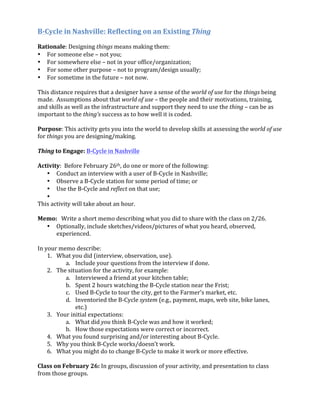
Design activity pdf
- 1. B-‐Cycle in Nashville: Reflecting on an Existing Thing Rationale: Designing things means making them: • For someone else – not you; • For somewhere else – not in your office/organization; • For some other purpose – not to program/design usually; • For sometime in the future – not now. This distance requires that a designer have a sense of the world of use for the things being made. Assumptions about that world of use – the people and their motivations, training, and skills as well as the infrastructure and support they need to use the thing – can be as important to the thing’s success as to how well it is coded. Purpose: This activity gets you into the world to develop skills at assessing the world of use for things you are designing/making. Thing to Engage: B-‐Cycle in Nashville Activity: Before February 26th, do one or more of the following: • Conduct an interview with a user of B-‐Cycle in Nashville; • Observe a B-‐Cycle station for some period of time; or • Use the B-‐Cycle and reflect on that use; • This activity will take about an hour. Memo: Write a short memo describing what you did to share with the class on 2/26. • Optionally, include sketches/videos/pictures of what you heard, observed, experienced. In your memo describe: 1. What you did (interview, observation, use). a. Include your questions from the interview if done. 2. The situation for the activity, for example: a. Interviewed a friend at your kitchen table; b. Spent 2 hours watching the B-‐Cycle station near the Frist; c. Used B-‐Cycle to tour the city, get to the Farmer’s market, etc. d. Inventoried the B-‐Cycle system (e.g., payment, maps, web site, bike lanes, etc.) 3. Your initial expectations: a. What did you think B-‐Cycle was and how it worked; b. How those expectations were correct or incorrect. 4. What you found surprising and/or interesting about B-‐Cycle. 5. Why you think B-‐Cycle works/doesn’t work. 6. What you might do to change B-‐Cycle to make it work or more effective. Class on February 26: In groups, discussion of your activity, and presentation to class from those groups.
